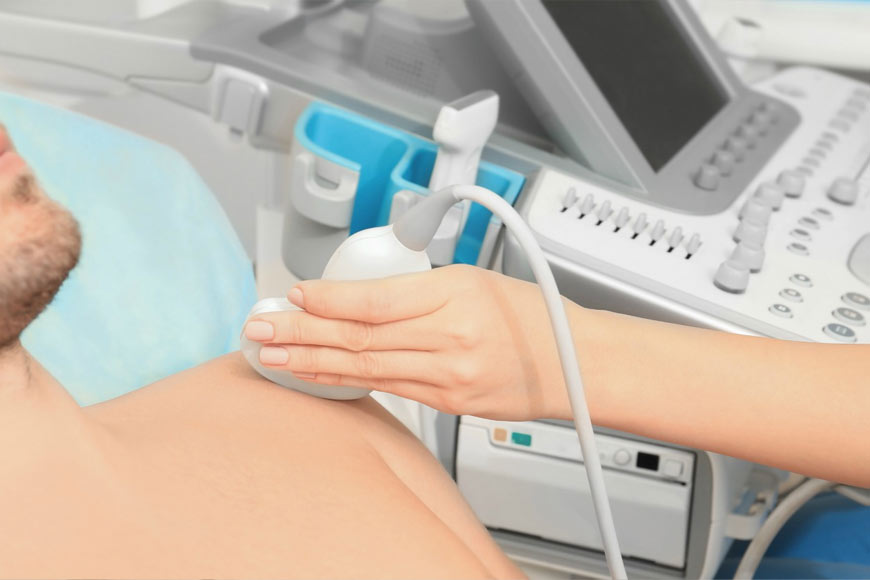Working Time
- Mon-Thu 08:00 - 20:00
Friday 07:00 - 22:00
Saturday 08:00 - 18:00
Contact Info
-
Phone: 011 240 40 46
011 407 82 31
064 258 89 85 - info@ffb.rs
Ask the Experts
Shoulder ultrasound

Shoulder joint
Are you suffering from shoulder pain? First, we'll explain what makes up a shoulder. The shoulder joint consists of three bones: the upper part of the upper arm (humerus), the scapula and the clavicle. The entire shoulder joint is surrounded by a joint capsule filled with fluid that lubricates the joint and makes it function properly. If the joint loses its mobility or part of its mobility, as a consequence, there is a reduced secretion of that fluid and further complications (arthrosis, crepitations, frozen shoulder, contractures in the joint itself). The walls of the capsule are made up of ligaments that connect the muscle to the bone.
Dynamic stabilizers of the shoulder are made up of four muscles: supraspinatus, infraspinatus, teres minor and subscapularis. They are responsible for the humerus standing firmly in the cup. The shoulder is the most mobile joint in our body, so injuries are very common.
Causes and symptoms
There are several possible causes for shoulder pain:
- Inflammation - infection or injury to part of the shoulder. Redness, swelling and pain may appear in a certain part of the shoulder. You feel that part of the shoulder is "hot". These symptoms occur as a natural reaction of the body to an infection or injury.
- Trauma (injury) or damage to the muscles and tendons around the shoulder - your posture in the upper body or neck can cause shoulder pain or tension in the muscles between the neck and shoulder. This pain occurs as a result of improper sitting at the computer or standing;
- Inflammation of the bursa - a fluid-filled cushion that normally helps muscles and tendons slide smoothly over the bones of the shoulder;
- Damage to the bones and cartilage of the shoulder - arthritis is the most common cause of this type of shoulder pain.
Shoulder pain is one of the most common reasons people seek physical therapy. Pain in the shoulder area very often occurs at night (it is often pain in the area of the biceps brachii tendon on the front of the shoulder, or in the very top of the shoulder of the supraspinatus tendon).
Shoulder pain is one of the most common reasons people seek physical therapy. Pain in the shoulder area very often occurs at night (it is often pain in the area of the biceps brachii tendon on the front of the shoulder, or in the very top of the shoulder of the supraspinatus tendon).
The cause of shoulder pain itself can be different, and that is why diagnostics in order to discover the cause of the pain is very important. The causes of shoulder pain can arise as a result of trauma (injury), microtrauma, overload, cold, etc.
Inflammation of the tendon in the shoulder or the formation of calcifications in the muscle itself can also be the cause of pain. Patients initially ignore the pain and try to relieve it with creams or analgesics. Unfortunately, the pain does not go away if you use creams or analgesics, but even increases over time. The shoulder joint itself is less mobile due to pain, which is why the joint is not lubricated. This leads to more severe pain in the shoulder during the day and night.
The appearance of calcifications in the shoulder muscle is related to overstrain of that part, and as a result, there is a micro-injury of the muscle itself. The calcification looks like a "little ridge" that the patient feels when moving
Shoulder diseases
- Arthrosis - loss and damage of cartilage;
- Arthritis - inflammation of the joints. Arthritis is a general name for more than 100 diseases, which are associated with joint inflammation. The three most common forms of arthritis include osteoarthritis, rheumatoid arthritis, and gout. Osteoarthritis is the most common type of arthritis and is caused by wear and tear of joint surfaces. One of the joints that is most often affected by arthritis is the knee, and osteoarthritis of the knee is also called gonarthrosis;
- Gonarthrosis - in gonarthrosis, the articular cartilage in the knee is damaged. The articular cartilage is a smooth surface that covers the end parts of the bones and has the role of cushioning movements in the joint and enabling smooth movements in the knee joint;
- Crepitations - clicking and scratching from the joints when moving the joint;
- Contractures in the joint itself - limitation of joint mobility in some or all directions, which can occur due to various pathological processes in the joint itself or the surrounding tissue. The limitation is permanent and refers to active and passive movements in the joint.
Shoulder ultrasound
Shoulder ultrasound shows soft tissue damage better than x-rays, small joint cartilage, cysts or tumors. A soft tissue ultrasound examination clearly shows possible damage to the soft tissues in the shoulder.






